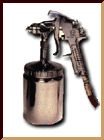 |
|
|
Filling wood grains with a paste wood filler
By Mac Simmons
Some woods have an open grain that makes it difficult to produce a smooth finish. To avoid this problem it is necessary to apply what is known as a grain filler prior to the application of wax or polish. In this article, Mac Simmons describes how to get the best finish using paste fillers.
Open grain, closed grain
Take a look at your skin; the small holes you can see in it are called pores. If you were to look at different species of woods you will find that some woods have no pores (or "grains"), some have small pores and others have larger pores. Woods with small pores are known as "closed grain woods" while woods with larger pores are classed as "open grained woods."
Piano Finish/Full Finish
Depending on the wood you are using and the type of finish you are trying to achieve, you may have to fill the wood's grain to get a satisfactory finish. Closed grain woods are normally not filled and in some cases, neither are open grained woods. It really depends upon the type of finish that you want. However, to achieve a "Piano Finish" (or Full Finish) it is necessary to fill these grains using a wood paste. A full finish is when the grains of the wood are completely filled and then leveled with the wood's surface, making the wood easier to finish with less coats of wax (or whatever the final finish is). By filling the wood grain you will save both time in finishing and money on your materials, because when the grain is filled (and therefore the filler and the wood's surface are smooth and level) you will use less coats of the elected finish (wax, varnish or whatever).
Paste Wood Filler
Paste Wood Fillers are made up of various materials such as Calcium Carbonate, Barium Hydroxide, Barlite, Silica and, in the case of colored paste fillers, paste colorants are added for colors. There are two different types of filler: Oil-based and water-based fillers. Oil pastes have an alkyd added to the filler, while water based fillers include a glycol. Oil type fillers take longer to dry than water-based fillers and can be cleaned up using Naptha (for water-based fillers, you can dilute or clean up with water).
Colored Paste Wood Fillers
Paste wood fillers come in different colors and can be used to either match the wood's natural colors, or as a contrasting color, depending on the finish that you are trying to achieve. As well as the colored pastes, you can also use a natural paste. This is typically used on lighter colored woods and can also be mixed with other oil-based fillers to make other colors. Further, you can add universal colorants to the oil-based fillers (particularly the natural filler) in order to more closely match the color that you want. For water-based fillers you can add dry powder pigment to make your own colors.
Applying the filler
Having chosen the type (and color) of filler, it is time to apply it to the wood. The preferred technique used to apply the filler varies depending on who you talk to. The filler can be applied with a brush, spread out with a plastic scraper or a cloth. Whichever application method you chose, you should apply the filler with a circular motion in order to ensure that the filler is successfully packed into the grain.
As you first apply the filler you will notice that the filler has a glossy sheen that begins to dull after a few minutes. Once the filler dulls it begins to harden. At this time, you should remove the excess paste before the filler becomes too hard as it is very difficult to remove then. Because of the limited time before the paste dulls, it is important to work on a small area at a time.
To remove the excess filler, use a plastic scraper, an old towel or a nylon scrubbing pad (experiment with all three to find one that suits your style of working). Remember, the more filler you leave on the wood, the harder it will be to sand off the wood later.
It is best to practice on a scrap piece of open grained wood before you try applying the paste for real. This will allow you to get used to how the paste wood fillers really work without risking your latest project. As well as testing the filler paste application technique, take the time to sand off this scrap piece of wood. This will allow you to test the final finish (wax or whatever) to make sure that the end result is what you expect.
In many cases, depending on the size of the open grains and the type of wood you are using, you will have to do two fillings in order to get the filler level with the surface of the wood. Once you have filled the grains and removed the excess filler, sand the surface smooth and then clean up the surface with a tack cloth to remove sawdust or other residue. You are now ready to either stain the wood or apply your clear coating (varnish, wax and so on). You can apply almost any type of finish, but if you have any doubts, consult the manufacturer of the paste.